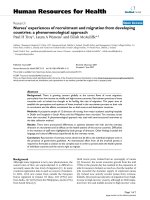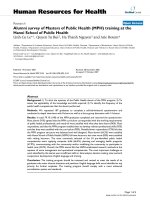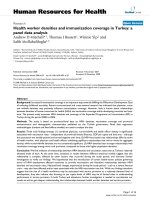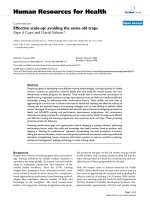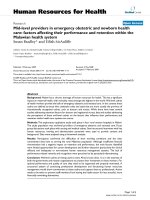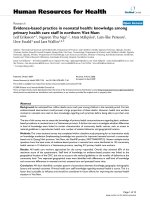báo cáo sinh học:" Health workforce attrition in the public sector in Kenya: a look at the reasons" ppt
Bạn đang xem bản rút gọn của tài liệu. Xem và tải ngay bản đầy đủ của tài liệu tại đây (223.75 KB, 8 trang )
BioMed Central
Page 1 of 8
(page number not for citation purposes)
Human Resources for Health
Open Access
Research
Health workforce attrition in the public sector in Kenya: a look at
the reasons
Slavea Chankova*
1
, Stephen Muchiri
2
and Gilbert Kombe
1
Address:
1
International Health Division, Abt Associates Inc., Bethesda, Maryland, USA and
2
Ministry of State for Planning, National Development
and Vision 2030, Nairobi, Kenya
Email: Slavea Chankova* - ; Stephen Muchiri - ;
Gilbert Kombe -
* Corresponding author
Abstract
Background: Kenya, like many other countries in sub-Saharan Africa, has been affected by
shortages of health workers in the public sector. Data on the rates and leading reasons for health
workers attrition in the public sector are key in developing effective, evidence-based planning and
policy on human resources for health.
Methods: This study analysed data from a human resources health facility survey conducted in
2005 in 52 health centres and 22 public hospitals (including all provincial hospitals) across all eight
provinces in Kenya. The study looked into the status of attrition rates and the proportion of
attrition due to retirement, resignation or death among doctors, clinical officers, nurses and
laboratory and pharmacy specialists in surveyed facilities.
Results: Overall health workers attrition rates from 2004 to 2005 were similar across type of
health facility: provincial hospitals lost on average 4% of their health workers, compared to 3% for
district hospitals and 5% for health centres. However, there are differences in the patterns of
attrition rates by cadre. Attrition among doctors and registered nurses was much higher at the
provincial hospitals than at district hospitals or health centres, whereas the opposite pattern was
observed for laboratory and pharmacy staff (lost at a higher rate in lower-level facilities). In
provincial hospitals, doctors had higher attrition rates than clinical officers, and registered nurses
had higher attrition rates than enrolled nurses. In contrast, attrition of enrolled and registered
nurses in district hospitals and health centres was similar. The main reason for health worker
attrition (all cadres combined) at each level of facility was retirement, followed by resignation and
death. However, resignation drives attrition among doctors and clinical officers; retirement
accounts for the main share of attrition among nurses and pharmacy staff; and death is the primary
reason for attrition among laboratory staff, particularly in district hospitals. One limitation of the
data is that sampling of health centres was non-random and the results may thus not be
representative of all health centres.
Conclusion: Our findings indicate that appropriate policies to retain staff in the public health
sector may need to be tailored for different cadres and level of health facility. Further studies,
perhaps employing qualitative research, need to investigate the importance of different factors in
the decision of health workers to resign.
Published: 21 July 2009
Human Resources for Health 2009, 7:58 doi:10.1186/1478-4491-7-58
Received: 16 April 2009
Accepted: 21 July 2009
This article is available from: />© 2009 Chankova et al; licensee BioMed Central Ltd.
This is an Open Access article distributed under the terms of the Creative Commons Attribution License ( />),
which permits unrestricted use, distribution, and reproduction in any medium, provided the original work is properly cited.
Human Resources for Health 2009, 7:58 />Page 2 of 8
(page number not for citation purposes)
Background
Human resources are the foundation of a health system
and a key prerequisite to improving health outcomes [1].
Many countries in sub-Saharan Africa have endemic
shortages of health workers, but the onset of the HIV/
AIDS epidemic has worsened the problem by dramatically
increasing the workload of hospital staff and directly
affecting many health workers who have become infected
with the virus [2-4].
In recent years, the situation of human resources for
health (HRH) in many sub-Saharan African countries has
been commonly described as "the crisis in human
resources for health" [5-7]. A key contributor to the crisis
is attrition of the health workforce, measured by the
number of health workers who permanently leave their
posts. Attrition is due to a number of reasons, including
retirement, death, dismissal and voluntary resignation by
health workers who leave the public health sector to work
in the private sector, for more attractive occupations in the
home country, or to emigrate to work in health facilities
in richer countries, in search of better pay and working
conditions. [8,9]
In Kenya, as in other countries in sub-Saharan Africa, the
HRH crisis has become a major challenge for health serv-
ice delivery and for achieving the health-related Millen-
nium Development Goals [4,10]. The public health sector
in Kenya provides about half of health care services in the
country [11].
The government has recognized that the emergence and
re-emergence of infectious diseases such as HIV/AIDS, TB
and malaria have increased the demand for health serv-
ices, putting an additional stress on the existing human
resources in the public health sector [12]. Prevalence of
HIV/AIDS in Kenya remains one of the highest in the
region, at 7.4% in 2007 [13].
As Kenya started receiving support for HIV/AIDS, TB,
malaria and immunization services from international
donors such as PEPFAR, GFATM and GAVI in 2004 –
2005, the country's ability to translate such funding into
improved and equitable health outcomes was threatened
by the lack of sufficient human resources in the health sec-
tor: in the public sector there were three doctors and 49
nurses per 100 000 population (compared to a ratio of
143 nurses per 100 000 population recommended by the
World Health Organization), and more than half of all
health personnel and 80% of doctors were based in urban
areas [14]. Shortages and misdistribution of HRH in the
public sector may also pose a major challenge to Kenya in
reaching the health-related Millennium Development
Goals [15].
Recognizing this problem, the government of Kenya has
declared shortages of health workers to be a major chal-
lenge to health development [16]; improving HRH has
become a top priority. In 2005, the Ministry of Health
conducted a human resource mapping and verification
census of all public health facilities in Kenya, finding
understaffed primary care facilities with relative overstaff-
ing of hospitals and lower health worker-to-population
ratios in poorer provinces [14].
Effective HRH planning and policy formulation in Kenya
and elsewhere require sound empirical evidence on why
and at what rate health workers leave the public health
sector. However, while anecdotal evidence of high attri-
tion rates among health workers in sub-Saharan African
countries abounds, most countries have weak human
resource information systems (HRIS) that cannot provide
adequate data on the rates of health worker attrition.
One way to obtain empirical data on HRH attrition, when
the data are not routinely available from a HRIS, is a
health facility survey. Surveys of available HRH resources
in developing countries have become more prevalent in
recent years, often as part of larger health services provi-
sion surveys [17]. However, service provision surveys
focus on the numbers and training characteristics of
health workers, and do not include questions about HRH
attrition. A number of recent studies focusing specifically
on HRH have documented the rate and main reasons of
HRH attrition in Ethiopia [18], Zambia [19], and Nigeria
[20], whereas other studies have explored the reasons why
health workers leave, or intend to leave, their posts
[3,21,22].
In this article, we report the findings on HRH attrition
from a nationwide health facility survey in the public
health sector in Kenya. The survey documented the overall
rate and reasons for attrition among key cadres of health
workers, including doctors, clinical officers, nurses and
laboratory and pharmacy specialists. The empirical evi-
dence we present illustrates differences in attrition pat-
terns by level of health facility. Our study aims to add to
the evidence on HRH attrition in sub-Saharan Africa, to
provide evidence for HRH planning in Kenya and to lay
the groundwork for further research needed to support
HRH policy decisions in Kenya and beyond.
Methods
The results presented here are based on data collected as
part of a health facility survey conducted in Kenya in 2005
by the USAID-sponsored Partners for Health Reform plus
project and the Kenya Ministry of Health. The survey cov-
ered 74 primary and secondary public sector health facili-
ties in all provinces of the country (Table 1). All seven
Human Resources for Health 2009, 7:58 />Page 3 of 8
(page number not for citation purposes)
provincial general hospitals were included in the sample.
A sample of 23 districts was selected across the eight prov-
inces. In each selected district, the district hospital (if there
was one) was included in the sample, and up to three
health centres were selected.
Selection of health centres was not random but was based
on their geographical proximity to the district hospital,
with selection preference for health centres that provided
HIV/AIDS or TB services (reflecting additional study
objectives related to provision of such services). Therefore
it is possible that the health centres in our sample are dif-
ferent from the average health centre in their area (e.g.
they may be larger in size, better equipped or situated in a
larger town or village). As a result, health centres in our
sample may experience different patterns of health worker
attrition, compared to the average for health centres in
their district. Our study does not include dispensaries, the
lowest health facility level.
A health facility questionnaire was administered to cogni-
zant staff members, including the medical director or the
staff in charge of HR management or administration. Data
were collected directly from facility registers; additional
information was provided by those interviewed. The ques-
tionnaire collected data on the number of health workers
employed in 2004 and 2005, as well as on the number
who had left and the number who had joined the facility
between mid-2004 and mid-2005, including the reason
for leaving. The list of reasons included resignation, retire-
ment, death and transfer to another health facility within
the public sector. The data collection took place in Octo-
ber – November 2005. EpiInfo data screens were used for
the data entry; all analysis was performed using Inter-
cooled Stata v.8.0 software.
We calculated average attrition rates by type of facility for
selected several cadres of health workers (excluding for-
eign workers). In the results presentation, we group labo-
ratory technicians and laboratory technologists in a
category that we call "laboratory staff", and we group
pharmacists and pharmaceutical technologists in a cate-
gory that we call "pharmacy staff". Attrition rate for each
facility was computed as the number of health workers
who left the facility between mid-2004 and mid-2005,
divided by the number of health workers who were
employed by the facility in mid-2004. We then computed
an average of the attrition rates for all facilities of a given
type (e.g. health centres) by health worker category. In
addition, we computed the share of total attrition at a
health facility that was due to resignation, retirement or
death, and compared the distribution of attrition reasons
across types of health facilities and health worker cadres.
It is important to keep in mind that all attrition rates pre-
sented in this study were computed at the individual facil-
ity level, and then averaged across facilities. Accordingly,
the attrition results reflect the situation faced by the aver-
age facility. One limitation of our study is that some
results are based on small sample sizes (e.g. if only a few
facilities report attrition of a given cadre, then the analyses
of reasons for attrition are based on data from only these
few facilities).
As the purpose of this study was to inform policy-makers
on the rate at which health workers leave public health
Table 1: Number of health facilities in study sample
a
Province Provincial hospitals District hospitals Health centres
Central 1 (1) 3 (15) 5 (66)
Coast 1 (1) 3 (16) 9 (38)
Eastern 1 (1) 2 (28) 5 (70)
Nairobi - (0) 1 (4) 6 (10)
North Eastern 1 (1) - (4) 2 (13)
Nyanza 1 (1) 2 (26) 8 (94)
Rift Valley 1 (1) 2 (38) 8 (132)
Western 1 (1) 2 (13) 9 (66)
Total 7 (7) 15 (144) 52 (489)
a
Total number of public health facilities in sampling frame shown in brackets.
Human Resources for Health 2009, 7:58 />Page 4 of 8
(page number not for citation purposes)
facilities and the reasons for that in Kenya, our calculation
of attrition took into account only those who had perma-
nently left the public health sector (i.e. those who
resigned, retired or died).
Results
Table 2 summarizes the number of health workers in the
health facilities included in our sample. At each level of
health facility, the largest category of health workers was
enrolled nurses, followed by registered nurses, clinical
officers, doctors and pharmacy and laboratory specialists.
While the average number of enrolled nurses was substan-
tially higher than that of registered nurses, the number of
clinical officers in district and provincial general hospitals
was about the same as the number of doctors in these
facilities. The average provincial general hospital had 38
doctors, 40 clinical officers, 262 nurses, 11 laboratory spe-
cialists and 22 pharmacy specialists. The average district
hospital in our sample had about half this number of
health workers (15 doctors, 19 clinical officers, 141
nurses, 4 laboratory and 13 pharmacy specialists). In
health centres, there was on average one clinical officer,
seven nurses (most of them enrolled nurses) and one
pharmacy specialist. One in five health centres had a lab-
oratory specialist.
Overall attrition rates
The attrition rate for the total number of health workers
(all cadres included in this study combined) was not sub-
stantially different by type of health facility: provincial
hospitals lost on average 4% of their health workers, com-
pared to 3% for district hospitals and 5% for health cen-
tres. However, there were marked differences in the
patterns of attrition rates by HRH cadre (Figure 1).
At all levels of care, attrition was highest among pharmacy
staff. Comparison of attrition rates by type of facility for
each cadre showed some interesting patterns. Attrition
among doctors and registered nurses was much higher at
the provincial hospitals than at district hospitals or health
centres, whereas the opposite pattern was observed for
laboratory and pharmacy staff (lost at a higher rate in
lower-level facilities).
On average, provincial hospitals lost doctors at twice the
rate in district hospitals (8% and 4%, respectively), while
registered nurses at provincial hospitals were lost at three
times the rate of registered nurses in district hospitals (6%
and 2%, respectively). On the other hand, the number of
laboratory staff decreased by less than 2% in provincial
hospitals, but by 7% to 8% in district hospitals and health
centres. While attrition for pharmacy staff was on average
10% in provincial hospitals, it reached 14% in district
hospitals and the few health centres that had pharmacy
staff (only 13% of health centres had any pharmacy staff).
At all types of facilities, attrition among clinical officers
was substantially lower than for doctors: about 2% at pro-
vincial hospitals and district hospitals and 3% at health
centres. While the attrition rate for registered nurses was
twice as high as for enrolled nurses at provincial hospitals
(6% and 3%, respectively), attrition for these two cadres
at lower levels of care was about the same (2% to 3% in
district hospitals and health centres).
Distribution of reasons for attrition across cadres and
health facility type
The main reason for health worker attrition at each level
of facility, when looking at all cadres combined, was
retirement (accounting for 48% to 58% of total attrition
at the average facility), followed by resignation and death
(Figure 2). Resignation accounted on average for 40% of
HRH attrition in provincial hospitals, 35% of attrition in
district hospitals and 25% of attrition in health centres.
However, a look at the reasons for attrition by type of
health workers shows different patterns. First, we looked
Table 2: Number of health workers per facility in study sample
a
Provincial general hospitals
(n = 7)
District hospitals
(n = 15)
Health centres
(n = 52)
Doctors 38 (12–72) 15 (5–53) -
Clinical officers 40 (17–108) 19 (10–29) 1.1 (0–3)
Registered nurses 89 (28–218) 34 (9–72) 1.3 (0–4)
Enrolled nurses 173 (6–322) 107 (46–212) 5.8 (0–16)
Laboratory technicians and technologists 11.1 (4–33) 4.3(1–8) 0.2 (0–2)
Pharmacists and pharmacy technicians 21.6 (10–37) 12.7 (7–20) 1.0 (0–4)
a
Range shown in brackets.
Human Resources for Health 2009, 7:58 />Page 5 of 8
(page number not for citation purposes)
at hospitals, which have each of the health worker cadres
included in the study. We combined provincial and dis-
trict hospitals for the purposes of this analysis. In hospi-
tals, resignation was the leading reason for loss of doctors
and clinical officers (accounting for more than 80% of
attrition), while the leading cause of attrition among
nurses and pharmacy staff was retirement, accounting for
two thirds or more of attrition in these groups (Figure 3).
The leading reason for attrition among laboratory staff in
hospitals was death (54% of attrition in hospitals that
reported loss of laboratory staff), while resignation
accounted only for 6% of attrition.
Average attrition rate by HRH category and type of health facilityFigure 1
Average attrition rate by HRH category and type of health facility.
7.5%
1.5%
6.2%
2.9%
1.5%
10.0%
3.7%
1.6%
2.4%
3.0%
6.5%
13.9%
3.0%
2.3%
2.0%
8.1%
14.3%
0
0.02
0.04
0.06
0.08
0.1
0.12
0.14
Doctors Clinical
Officers
Registered
Nurses
Enrolled
Nurses
Lab staff Pharm. staff
average attrition rate
Provincial General Hospitals District Hospitals Health Centers
Distribution of reasons for HRH attrition by type of health facilityFigure 2
Distribution of reasons for HRH attrition by type of
health facility.
40%
35%
25%
51%
48%
58%
9%
17%
17%
0%
10%
20%
30%
40%
50%
60%
70%
80%
90%
100%
Provincial General Hospitals (n=7) District Hospitals (n=15) Health Centers (n=17)
% of total attrition
Resigned Retired Died
Reasons for attrition of health workers in provincial and dis-trict hospitalsFigure 3
Reasons for attrition of health workers in provincial
and district hospitals.
87%
83%
20%
32%
6%
8%
17%
65%
68%
41%
6%
15%
54%
0%
10%
20%
30%
40%
50%
60%
70%
80%
90%
100%
Doctors Clinical Officers Nurses Pharm. staff Lab staff
% of total attrition
Resigned Retired Died
Human Resources for Health 2009, 7:58 />Page 6 of 8
(page number not for citation purposes)
The pattern of attrition reasons for each cadre was the
same at provincial hospitals and district hospitals, except
for registered nurses and laboratory staff. Resignation
accounted for about half of attrition in provincial hospi-
tals, but for only 17% in district hospitals (where retire-
ment was the leading reason for loss of registered nurses).
While resignation was the only reason for laboratory staff
lost in provincial hospitals, death was the leading reason
for laboratory staff attrition in district hospitals, account-
ing for 75% of attrition of laboratory staff.
Unlike hospitals, the proportion of health centres in our
sample that reported loss of health workers for each cadre
was very low. Between two and six of the 52 health centres
reported loss of health workers from a given cadre,
although nearly all health centres had at least one
enrolled nurse (92%), 85% had at least one registered
nurse, 87% had at least one clinical officer and 60% had
laboratory staff. In health centres, retirement was the lead-
ing reason for attrition among all cadres combined,
accounting for at least half of attrition (Figure 2). Retire-
ment remained the leading reason for attrition when
looking separately at registered nurses, enrolled nurses
and laboratory staff (the cadres that are most prevalent in
health centres) (Figure 4).
Resignation was the reason for 33% of attrition among
registered nurses, 17% among enrolled nurses and 25%
among laboratory staff. Only two of the 45 health centres
with clinical officers reported loss of this cadre, with half
of attrition due to retirement and the rest due to resigna-
tion. Similarly, only two of the seven health centres that
had pharmacy staff reported loss of such staff, all due to
retirement.
Discussion
Our results highlight several areas for discussion. First, the
overall attrition rate (all health worker cadres combined)
at the average provincial hospital was not much different
from attrition at the average district hospital or health cen-
tre in our sample. This finding is in contrast with the typ-
ical concern voiced by researchers and policy-makers that
primary health facilities, in sub-Saharan Africa and else-
where, tend to lose health workers at a higher rate, com-
pared to secondary and tertiary facilities.
In hospitals, doctors had much higher rates of attrition,
compared to clinical officers, although resignation was
the predominant reason for attrition in both cadres. This
finding may reflect a recent trend for doctors, who may be
moving completely away from public service rather than
staying on with the dual employment opportunity (often
referred to as "moonlighting") that has been on the books
for years. The differential rates of attrition between doc-
tors and clinical officers may thus reflect that doctors are
more likely to emigrate for work in health facilities abroad
or to go completely into private practice or employment
in the NGO sector in the home country (which are not
opportunities as readily available to clinical officers).
Attrition among registered nurses in provincial hospitals
was, on average, twice as high as the rate of attrition of
enrolled nurses. While resignation accounted for about
half of attrition among registered nurses at this level, the
loss of enrolled nurses was nearly all due to retirement. By
contrast, at lower facility levels, registered and enrolled
nurses had similar rates of attrition, mostly explained by
retirement. This may reflect the higher international
mobility and more numerous alternative employment
opportunities available to registered nurses (in compari-
son with enrolled nurses), particularly in urban areas
where the provincial hospitals are located.
The high levels of attrition among pharmacy staff across
all facility levels (10% to 14%) were due primarily to
retirement. This may have been a result of non-replace-
ment of this cadre over time, leading to an aged pool of
these personnel. That resignation was not as prominent a
reason for attrition in this group may reflect the lack of
better opportunities in the private health sector for phar-
macy specialists.
Attrition among laboratory staff at provincial hospitals
and health centres was explained by retirement, while the
predominant reason in district hospitals was death. The
high proportion of deaths accounting for attrition among
laboratory staff in district hospitals is worrying and must
be explored further to identify the causes. That retirement
also accounts for a high proportion of laboratory staff
attrition indicates that this cadre may be an elderly section
Reasons for attrition of health workers in health centresFigure 4
Reasons for attrition of health workers in health cen-
tres.
33%
17%
25%
50%
67% 50%
17% 17%
25%
0%
20%
40%
60%
80%
100%
Registered Nurses Enrolled Nurses Lab staff
% of total attrition
Resigned Retired Died
Human Resources for Health 2009, 7:58 />Page 7 of 8
(page number not for citation purposes)
of the workforce and that the provision of laboratory serv-
ices may need to be addressed urgently.
There are several areas in need of in-depth future research,
based on these results. Our finding that resignation was
the predominant reason for relatively high attrition
among doctors and registered nurses in provincial hospi-
tals can benefit from further research on the factors that
led these cadres to resign. Similarly, research among the
cadres where resignation accounted for a small share of
health worker loss (such as enrolled nurses and laboratory
and pharmacy staff) may shed light on factors successful
in keeping these health workers at their posts. Qualitative
research methods can be particularly relevant in investi-
gating such factors. This type of further research will
inform retention policies and help prioritize resources
towards areas that are most important for keeping the dif-
ferent health cadres in their posts – whether higher sala-
ries, professional opportunities or other factors.
Studies from other countries as to why health workers
resign have found that the main reasons are low pay; poor
working and living conditions at the sites where they are
posted [1,23]; and reasons related to the HIV/AIDS epi-
demic, such as fear of becoming infected on the job and
overwhelming workload and stress induced by caring for,
and seeing high death rates among, HIV/AIDS patients
[4]. For health workers in rural areas, an additional prob-
lem is inadequate quality of housing, transport and
schools for their children. Those "push" factors combine
with "pull" factors such as better pay and opportunities
available in other occupations or health facilities abroad
[21,22,24-27]. Investigating the role of these factors for
health worker resignations in Kenya – particularly
whether different factors play a role for different cadres –
would inform and strengthen retention policies in Kenya.
A few limitations of our study need to be highlighted.
First, our survey covered only one year, and it is possible
that attrition trends may vary over years. Second, our sur-
vey did not measure absenteeism among health workers,
which is another aspect of the shortage of health workers
at facilities [4]. While further research and interventions
to address the attrition of health workers from the public
sector are of key importance, absenteeism among health
workers would also need to be on the research and policy
agenda. Lastly, this study did not measure attrition differ-
ences between rural and urban areas, or attrition and rea-
sons for resignation by gender, which are important areas
where further research would be particularly valuable.
Conclusion
The evidence provided in this study highlights the need to
develop appropriate policies to retain staff in the public
health sector that may need to be tailored for different
cadres and level of health facility. Although there has been
heavy investment by both the Government and the devel-
opment partners in the health sector, it is now evident that
without earmarking some funds to increase the pool of
human resources, Kenya is unlikely to achieve the health
related MDGs.
In the last few years, development partners have provided
funds to hire additional workers on contract; those work-
ers are posted to districts on the condition that they must
remain in the posted station for the entire duration of the
contract. This has assisted in retaining staff, especially in
underserved areas. Further research into differences in
attrition patterns by gender or region would help in
designing retention incentives and shaping the composi-
tion of intakes to medical and nursing schools.
One solution to alleviating shortages of doctors that is
gaining prominence in the HRH debate and practice is
increasing the numbers of non-physician clinicians (such
as clinical officers) and shifting tasks that can be handled
by non-physicians [28,29]. Other policy suggestions to
address resignations are to improve the salary package for
health workers and the working environment in public
health facilities. As the HRH crisis persists, it is ironic that
some developing countries are considering abolishing the
training of enrolled nurses – who are more likely to stay at
their posts in the public sector, compared to registered
nurses – in favour of more expensive and qualified regis-
tered nurses.
List of abbreviations
GAVI: Global Alliance for Vaccines and Immunization;
GFATM: Global Fund to Fight AIDS, Tuberculosis and
Malaria; PEPFAR: President's Emergency Plan for AIDS
Relief; USAID: United States Agency for International
Development
Competing interests
The authors declare that they have no competing interests.
Authors' contributions
SC analysed the data and drafted the manuscript. GK and
SM led the design of the study, managed the data collec-
tion and contributed to the manuscript draft. All authors
read and approved the final manuscript.
Acknowledgements
The authors wish to acknowledge the contributions of Geoffrey Kimani for
assisting with the management of data collection, Nancy Pielemeier for
guidance of the research and Ann Lion and Marc Luoma for review of an
earlier draft. We appreciate the support of the managers of the health facil-
ities included in the study, and the efforts of all survey data collectors.
Financial support for this research was provided by the United States
Agency for International Development (USAID) under Prime Contract No.
HRN-C-00-00-00019-00 awarded to Abt Associates Inc. and by a grant to
Publish with Bio Med Central and every
scientist can read your work free of charge
"BioMed Central will be the most significant development for
disseminating the results of biomedical research in our lifetime."
Sir Paul Nurse, Cancer Research UK
Your research papers will be:
available free of charge to the entire biomedical community
peer reviewed and published immediately upon acceptance
cited in PubMed and archived on PubMed Central
yours — you keep the copyright
Submit your manuscript here:
/>BioMedcentral
Human Resources for Health 2009, 7:58 />Page 8 of 8
(page number not for citation purposes)
the primary author from Abt Associates Inc. The opinions expressed herein
are the authors' and do not necessarily reflect the views of Abt Associates
Inc. or USAID. All errors remain the responsibility of the authors.
References
1. World Health Organization: The World Health Report 2006: Working
Together for Health. Geneva 2006.
2. World Health Organization: Scaling Up HIV/AIDS Care: Service Delivery
and Human Resources Perspectives. Geneva 2004.
3. Kober K, Van Damme W: Public sector nurses in Swaziland: can
the downturn be reversed? Human Resources for Health 2006,
4:13.
4. Republic of Kenya Ministry of Health: Report on Challenges Facing the
Kenyan Health Workforce in the Era of HIV/AIDS. Nairobi 2004.
5. Liese G, Dussault C: The State of the Health Workforce in Sub-Saharan
Africa: Evidence of Crisis and Analysis of Contributing Factors Washington,
DC: Africa Region Human Development Working Paper Series,
World Bank; 2004.
6. L Chen TE: Human resources for health: overcoming the cri-
sis. Lancet 2004, 364:1984-1990.
7. Smith M, Henderson-Andrade N: Facing the health worker crisis
in developing countries: a call for global solidarity. Bull World
Health Organ 2006, 84(6):426-427.
8. Dovlo D: Wastage in the health workforce: some perspec-
tives from African countries. Human Resources for Health 2005,
3:6.
9. Training and Research Support Center: Health Worker Retention and
Migration in East and Southern Africa: Regional Meeting Report from EQUI-
NET/ECSA-CH Meeting. Arusha 2007 [ />bibl/docs/REPMTG0307HRH.pdf].
10. Government of Kenya: Millennium Development Goals Status Report for
Kenya 2005. Nairobi 2005.
11. National Coordinating Agency for Population and Development, Min-
istry of Health, Central Bureau of Statistics, ORC Macro: Kenya Serv-
ice Provision Assessment Survey 2004. Nairobi 2005.
12. Republic of Kenya Ministry of Health: Kenya National Health Sector
Strategic Plan 2005 – 2010. Nairobi 2005.
13. Republic of Kenya, Kenya National Bureau of Statistics: Kenya AIDS
Indicator Survey. Nairobi 2007.
14. Republic of Kenya Ministry of Health: Report on Human Resources Map-
ping and Verification Exercise. Nairobi 2006.
15. Chankova S, Kombe G, Muchiri S, Decker C, Kimani G, Pielemeier N:
Rising to the Challenges of Human Resources for Health in Kenya: Devel-
oping Empirical Evidence for Policy Making Bethesda, MD: The Partners
for Health Reformplus Project, Abt Associates Inc; 2006.
16. Republic of Kenya Ministry of Health: Public Expenditure Review 2005:
Delivering ERS Priorities. Nairobi 2005.
17. MEASURE/DHS, Service Provision Assessments: Overview. [http:/
/www.measuredhs.com/aboutsurveys/spa/start.cfm].
18. Kombe G, Galaty D, Gadhia R, Decker C: Human and Financial
Resource Requirements for Scaling Up HIV/AIDS Services in Ethiopia
Bethesda, MD: The Partners for Health Reformplus Project, Abt
Associates Inc.; 2004.
19. Kombe G, Galaty D, Mtonga V, Banda P: Human Resource Crisis in Zam-
bia's Health System: A Call for Urgent Action. Assessment Report Bethesda,
MD: The Partners for Health Reformplus Project, Abt Associates Inc.;
2004.
20. Chankova S, Nguyen H, Chipanta D, Kombe G, Onoja A, Ogungbemi
K: A Situation Assessment of Human Resources the Public Health Sector in
Nigeria Bethesda, MD: The Partners for Health Reformplus Project,
Abt Associates Inc.; 2006.
21. Hagopian AO, Fatusi A, Biritwum R, Essel A, Hart LG, Watts C: The
flight of physicians from West Africa: Views of African physi-
cians and implications for policy. Soc Sci Med 2005,
61(8):1750-1760.
22. Nguyen L, Ropers S, Nderitu E, Zuyderduin A, Luboga S, Hagopian A:
Intent to migrate among nursing students in Uganda: meas-
ures of the brain drain in the next generation of health pro-
fessionals. Human Resources for Health 2008, 6(1):5.
23. Matsiko C, Kiwanuka J: A review of human resources for health
in Uganda. Journal of Health Policy and Development 2003,
1(1):15-20.
24. Connell J, Zurn P, Stillwell B, Awases M, Braichet J-M: Sub-Saharan
Africa: Beyond the health worker migration crisis? Soc Sci
Med 2007, 64(9):1876-1891.
25. Eastwood J, Conroy R, Naicker S, West P, Tutt R, Plange-Rhule J:
Loss of health professionals from sub-Saharan Africa: the
pivotal role of the UK. Lancet 2005, 365:1893-1900.
26. Pang T, Lansang M, Haines A: Brain drain and health profession-
als. BMJ 2002, 324:499-500.
27. Vujicic M, Zurn P, Diallo K, Adams O, Dal Poz MR: The role of
wages in the migration of health care professionals from
developing countries. Human Resources for Health 2004, 2(1):3.
28. Mullan F, Frehywot S: Non-physician clinicians in 47 sub-Saha-
ran African countries. Lancet 2007, 370:2158-2163.
29. Dovlo D: Using mid-level cadres as substitutes for interna-
tionally mobile health professionals in Africa. A desk review.
Human Resources for Health 2004, 2:7.
